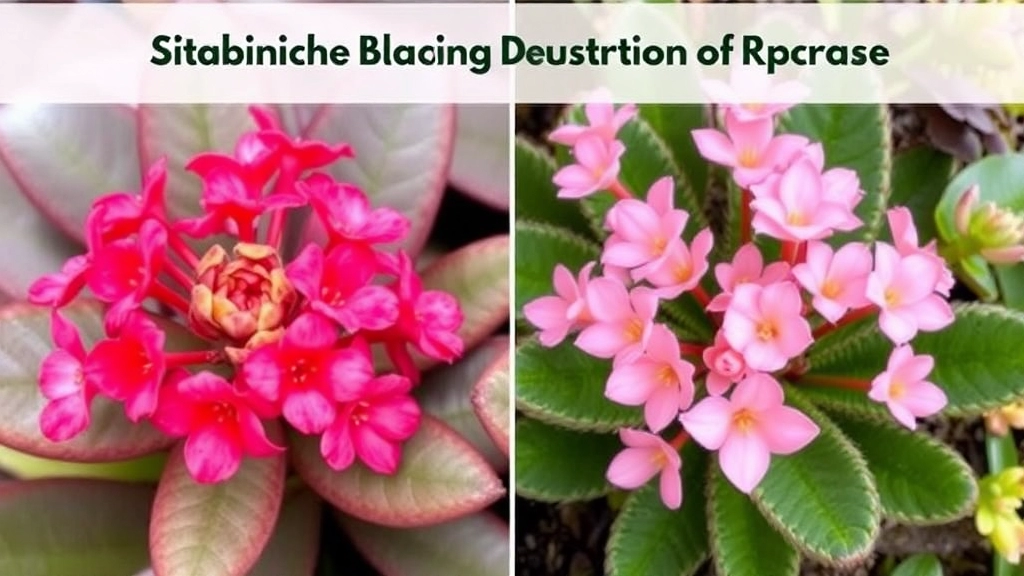Exploring Kalanchoe Species
When it comes to exploring the different Kalanchoe species, there’s a world of variety waiting to be discovered. From the classic Kalanchoe Blossfeldiana with its vibrant blooms to the unique foliage of the Panda Plant and Chocolate Soldier, each species brings something special to the table. For indoor beauty, flowering Kalanchoes are a top pick, while hardy and drought-tolerant varieties are perfect for those seeking low-maintenance options.
Majestic Varieties
If you’re looking for something majestic, the Kalanchoe Beharensis stands out as a stunning shrub. Fast-growing species like the Mother of Thousands can quickly fill your space, and hanging varieties are ideal for decorative displays.
Caring for Your Kalanchoes
Whether you’re after colorful foliage for your garden or easy-care plants for your home, understanding the care tips and ideal conditions for each species ensures your Kalanchoes thrive.
When it comes to choosing Kalanchoe plants, many enthusiasts often find themselves overwhelmed by the diverse options available.
Kalanchoe is not just a single type of plant; it encompasses a variety of species, each with its unique charm and characteristics.
## Key Varieties to Explore
Here are some of the most popular Kalanchoe varieties that you might consider adding to your collection:
– **Kalanchoe Blossfeldiana**: Known for its vibrant flowers, this classic favourite is a staple in many homes.
– **Panda Plant (Kalanchoe tomentosa)**: With its fuzzy leaves and unique appearance, it’s a delightful addition to any indoor garden.
– **Chocolate Soldier (Kalanchoe marmorata)**: This variety boasts striking marbled foliage, making it a visual standout.
– **Kalanchoe Beharensis**: A majestic shrub that can grow quite large, perfect for those looking for a statement plant.
– **Mother of Thousands (Kalanchoe daigremontiana)**: A fast-growing species that produces numerous offsets, ideal for propagation enthusiasts.
Each of these varieties brings something special to the table, whether it’s stunning blooms or unique foliage. For those interested in propagation, the [Mother of Thousands](https://planthq.org/buy-kalanchoe-mother-of-thousands-online-best-deals/) is particularly rewarding. If you’re looking for detailed care instructions, be sure to check out our [Panda Plant care guide](https://planthq.org/how-to-care-for-kalanchoe-tomentosa-complete-guide/).
Kalanchoe Blossfeldiana: The Classic Favorite
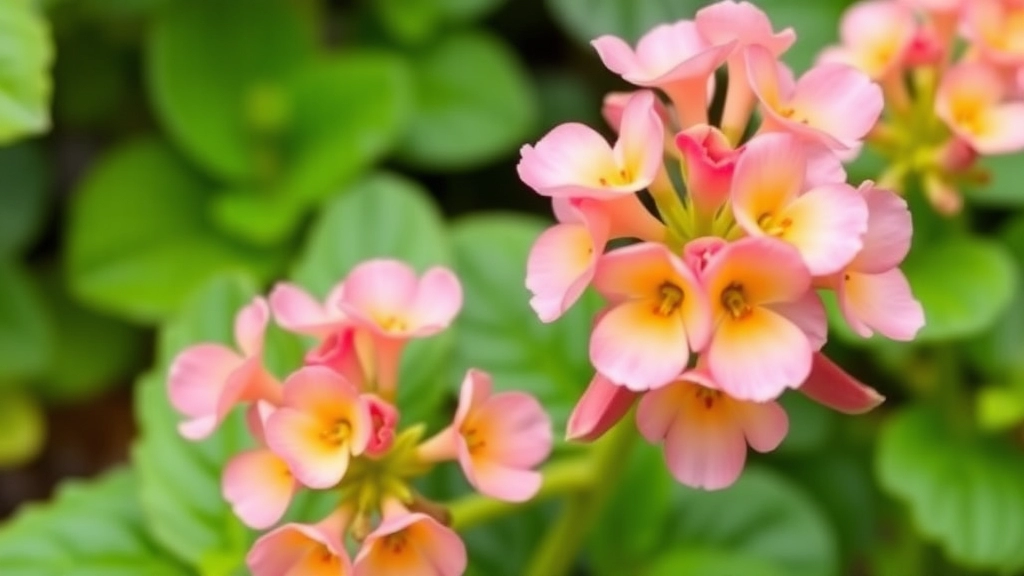
Ever wondered why Kalanchoe Blossfeldiana is often hailed as the classic favourite among plant lovers?
This vibrant little succulent brings a splash of colour and charm to any indoor space, making it a top choice for many.
Why Kalanchoe Blossfeldiana Stands Out
- Stunning Blooms: With clusters of bright flowers in shades of red, pink, yellow, and white, it’s like having a mini garden right in your home.
- Long-Lasting: These flowers can last for weeks, providing you with a long-lasting display of beauty.
- Easy to Care For: Perfect for beginners, it thrives on minimal attention.
Care Tips for Kalanchoe Blossfeldiana
- Light: Place it in a spot with bright, indirect sunlight. Too much direct sun can scorch the leaves.
- Watering: Allow the soil to dry out between waterings. Overwatering can lead to root rot, so less is often more.
- Temperature: This plant loves warmth. Keep it in a room that’s between 15°C and 25°C.
Fun Fact
Did you know that Kalanchoe Blossfeldiana is often given as a gift? Its cheerful blooms make it a thoughtful gesture for birthdays and celebrations.
As we explore the fascinating world of Kalanchoe, let’s delve into two standout varieties known for their unique foliage: the Panda Plant and the Chocolate Soldier.
### Panda Plant (Kalanchoe tomentosa)
The Panda Plant is a delightful succulent that captivates with its fuzzy, grey-green leaves adorned with brown edges.
– **Care Tips:**
– Prefers bright, indirect sunlight.
– Water sparingly; allow the soil to dry out between waterings.
– Thrives in well-draining soil.
This plant is not just a visual treat; it’s also incredibly resilient. Its soft, velvety leaves make it a favourite among succulent enthusiasts. I recall the first time I touched a Panda Plant; it felt like petting a soft toy, instantly making it a charming addition to my collection. For more detailed care instructions, you can refer to the [complete guide to growing Kalanchoe Mother of Thousands](https://planthq.org/complete-guide-to-growing-kalanchoe-mother-of-thousands/).
### Chocolate Soldier (Kalanchoe luciae)
Next up is the Chocolate Soldier, which stands out with its striking, paddle-shaped leaves that transition from green to a rich burgundy hue, resembling a chocolate treat.
– **Care Tips:**
– Enjoys full sun for vibrant colours.
– Requires minimal water; overwatering can lead to root rot.
– Prefers a slightly acidic to neutral soil pH.
The Chocolate Soldier is a true conversation starter. I remember showcasing it to a friend who was amazed by its colour transformation under different lighting. It’s a testament to how Kalanchoe can bring life and personality to any space. If you’re interested in other Kalanchoe varieties, check out this [guide to Kalanchoe Beharensis varieties](https://planthq.org/exploring-kalanchoe-beharensis-varieties-care-characteristics/).
Both the Panda Plant and Chocolate Soldier not only offer unique foliage but also add a touch of elegance to indoor gardens.
Flowering Kalanchoes for Indoor Beauty
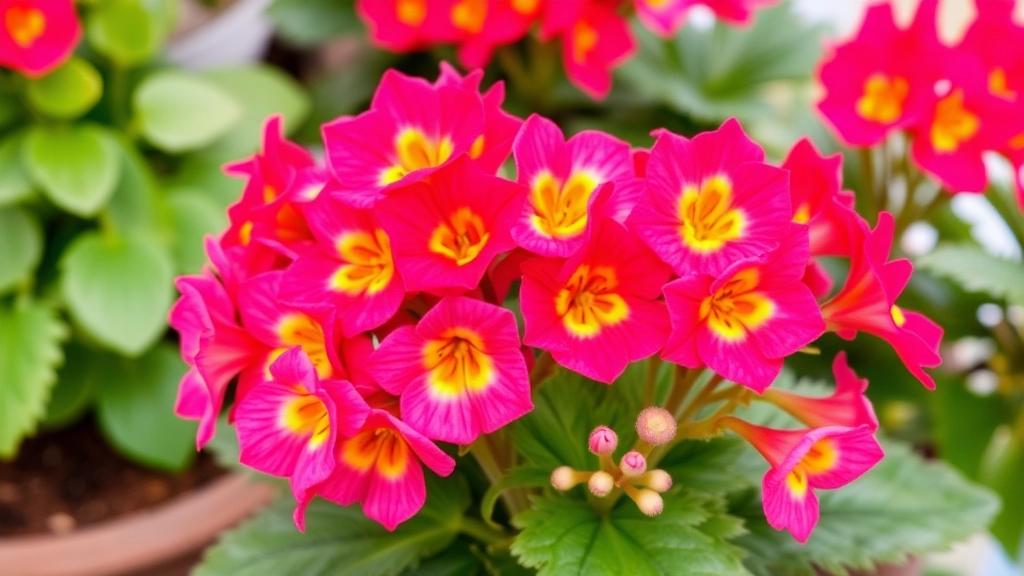
Are you looking to brighten up your indoor space with vibrant, flowering plants?
Flowering Kalanchoes are an excellent choice for adding colour and charm to your home.
These hardy succulents are not only easy to care for but also produce stunning blooms that can last for weeks.
Popular Flowering Varieties
- Kalanchoe Blossfeldiana
- Known for its clusters of small, brightly coloured flowers.
- Blooms in shades of red, pink, yellow, and white.
- Ideal for windowsills and tabletops.
- Kalanchoe Tomentosa (Panda Plant)
- While primarily known for its unique foliage, it also produces delicate flowers.
- Adds a touch of elegance with its fuzzy leaves.
- Kalanchoe Pinnata (Mother of Thousands)
- Features small, bell-shaped flowers.
- A fast-growing option that can fill your space quickly.
Care Tips for Flowering Kalanchoes
- Light:
Place your Kalanchoe in a bright, sunny spot. They thrive in indirect sunlight. - Watering:
Water only when the top inch of soil feels dry. Overwatering can lead to root rot. - Temperature:
Ideal temperatures range from 18°C to 24°C. Avoid cold drafts. - Fertilisation:
Use a balanced fertiliser every month during the growing season for optimal blooms.
Hardy and Drought-Tolerant Kalanchoe Varieties
Are you tired of plants that wilt at the first sign of neglect?
If so, hardy and drought-tolerant Kalanchoe varieties might just be what you need.
These resilient beauties not only survive but thrive in challenging conditions, making them perfect for busy lifestyles or less-than-ideal environments.
Top Hardy Kalanchoe Varieties
- Kalanchoe luciae (Paddle Plant)
- Known for its thick, paddle-shaped leaves.
- Can withstand long periods without water.
- Features stunning red edges when exposed to sunlight.
- Kalanchoe tomentosa (Panda Plant)
- Soft, fuzzy leaves with a unique appearance.
- Extremely drought-tolerant and low-maintenance.
- Ideal for beginners and busy plant parents.
- Kalanchoe beharensis (Felt Plant)
- Large, textured leaves that resemble felt.
- Thrives in poor soil and requires minimal watering.
- Can grow into a small shrub, adding structure to your garden.
- Kalanchoe fedtschenkoi (Lavender Scallops)
- Distinctive scalloped leaves with a lovely lavender hue.
- Tolerates drought and poor soil conditions.
- A great choice for both indoor and outdoor settings.
Benefits of Hardy Kalanchoe
- Low Maintenance: Perfect for those who may forget to water regularly.
- Versatile: Suitable for both indoor and outdoor gardens.
- Aesthetic Appeal: Adds unique textures and colours to your plant collection.
These hardy varieties are not just resilient; they also bring a striking presence to any space. For more in-depth care tips, check out our Kalanchoe luciae care guide and our comprehensive Kalanchoe tomentosa care guide.
Kalanchoe Beharensis: The Majestic Shrub
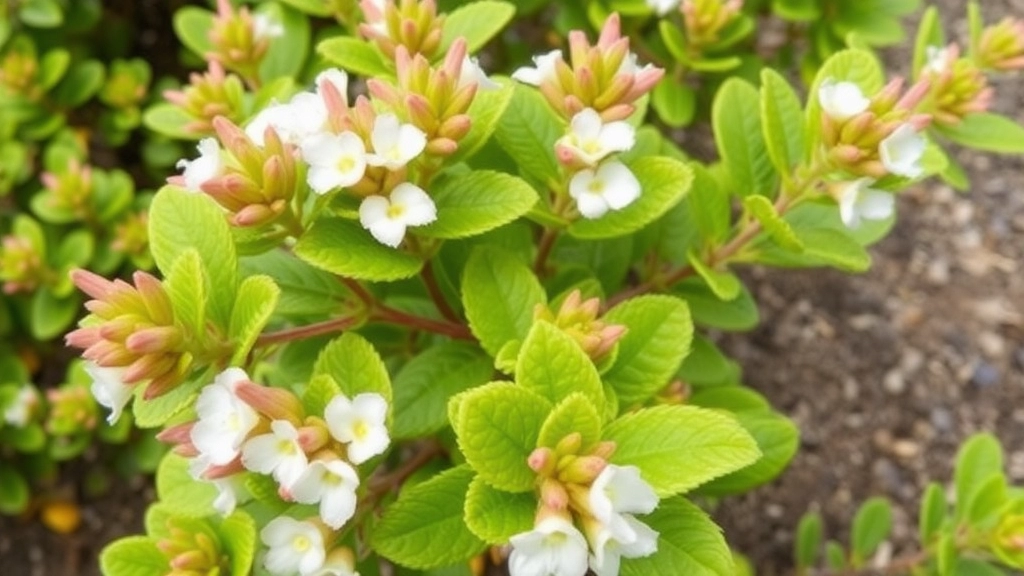
So, you’ve got your eye on Kalanchoe Beharensis? Great choice! This beauty is not just another succulent; it’s a majestic shrub that can transform your space.
What Makes Kalanchoe Beharensis Stand Out?
- Size and Structure: It can grow up to 1.2 meters tall, making it a striking addition to any collection.
- Unique Leaves: Its large, paddle-shaped leaves have a greyish-green hue, often with a velvety texture that adds a touch of elegance.
- Sturdy Stems: The thick, sturdy stems give it a robust appearance, perfect for those looking for a hardy plant.
Care Tips for Kalanchoe Beharensis
- Light: Loves bright, indirect sunlight. Too much direct sun can scorch those lovely leaves.
- Watering: Allow the soil to dry out between waterings. This plant is drought-tolerant, so don’t overdo it!
- Soil: A well-draining cactus mix works wonders. You want to keep it happy and healthy.
Why Choose Kalanchoe Beharensis?
If you’re after a low-maintenance plant that makes a statement, this is it. Plus, it’s perfect for both indoor and outdoor settings.
I remember the first time I spotted one in a friend’s garden. It stood out like a beacon, and I knew I had to have one.
Mother of Thousands: A Fast-Growing Kalanchoe
When discussing Kalanchoe varieties, one that truly stands out is the Mother of Thousands.
This remarkable plant is known for its rapid growth and unique propagation method.
Key Features of Mother of Thousands:
- Propagation: The Mother of Thousands produces tiny plantlets along the edges of its leaves.
- Growth Rate: It can quickly fill a pot or garden space, making it an ideal choice for those seeking a lush appearance without a long wait.
- Resilience: This Kalanchoe is hardy and can thrive in various conditions, which is a significant advantage for both novice and experienced gardeners.
Care Tips for Mother of Thousands:
- Light: Prefers bright, indirect sunlight.
- Watering: Allow the soil to dry out between waterings to avoid root rot.
- Soil: Well-draining potting mix is essential for optimal growth. For more detailed information, check out the Mother of Thousands care guide.
I remember the first time I saw a Mother of Thousands in a friend’s garden. The sheer number of plantlets cascading from the leaves was astonishing. It felt like a mini jungle, and I was instantly drawn to its beauty.
However, be mindful that its prolific nature can lead to overpopulation in your garden if not managed. If you’re interested in exploring other Kalanchoe varieties, you might find the guide to 150 species of Kalanchoe insightful.
Hanging Kalanchoe Species: Perfect for Display
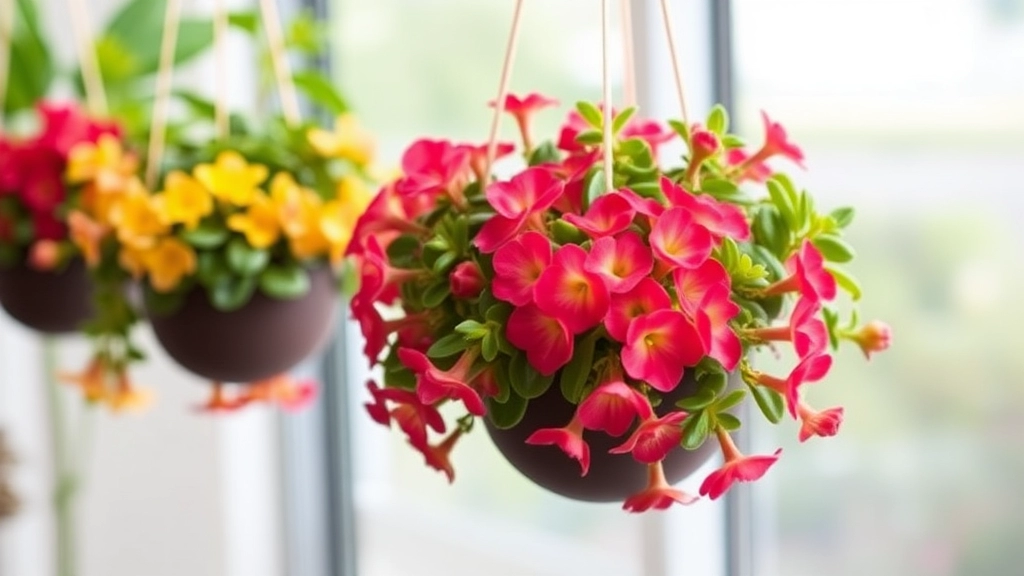
Ever wondered how to add a splash of life to your living space without taking up too much room? Hanging Kalanchoe species are your answer! These beauties not only bring a pop of colour but also create a stunning visual impact, perfect for any indoor or outdoor setting.
Why Choose Hanging Kalanchoe?
- Space-Saving: Great for small spaces or to elevate your décor.
- Visual Appeal: Their cascading leaves and flowers create a lovely waterfall effect.
- Easy to Care For: Perfect for those of us who might not have a green thumb.
Popular Hanging Varieties
- Kalanchoe tomentosa (Panda Plant):
- Soft, fuzzy leaves with a unique look.
- Great for adding texture to your plant collection.
- Kalanchoe marmorata (Chocolate Soldier):
- Distinctive marbled leaves that catch the eye.
- A conversation starter for sure!
- Kalanchoe beharensis (Felt Plant):
- Large, felt-like leaves that hang beautifully.
- Adds a dramatic touch to your space.
Care Tips for Hanging Kalanchoe
- Light: They love bright, indirect sunlight.
- Water: Let the soil dry out between waterings to prevent root rot.
- Fertiliser: A diluted cactus fertiliser during the growing season keeps them thriving.
Picture this: You come home after a long day, and the sight of your hanging Kalanchoe instantly lifts your spirits.
When considering Kalanchoe for your garden, the vibrant foliage varieties can truly elevate your outdoor space. Many gardeners often overlook the stunning leaves of Kalanchoe, but these plants offer a palette of colours that can complement any garden design.
### Top Colorful Foliage Varieties
– **Kalanchoe luciae (Paddle Plant)**
– Features large, paddle-shaped leaves with a striking red edge.
– Ideal for adding a splash of colour to rock gardens or succulent arrangements. For more information, check out the [Kalanchoe Paddle Plant Flower Care Guide](https://planthq.org/kalanchoe-paddle-plant-flower-care-guide/).
– **Kalanchoe thyrsiflora (Flapjack Plant)**
– Known for its vibrant, round leaves that turn reddish in full sun.
– Perfect for container gardening or as a focal point in a mixed planting.
– **Kalanchoe beharensis (Elephant Bush)**
– Displays thick, grey-green leaves with a velvety texture.
– A robust choice for creating a lush, tropical vibe. You can learn more in the [Care and Propagation of Kalanchoe Beharensis Snowflake](https://planthq.org/care-and-propagation-of-kalanchoe-beharensis-snowflake/).
– **Kalanchoe tomentosa (Panda Plant)**
– Characterised by its fuzzy leaves with brown edges.
– Adds a unique touch to any outdoor display.
### Why Choose Colorful Foliage?
– **Visual Interest**: Colourful foliage can create a dynamic and engaging landscape.
– **Versatility**: These plants work well in various settings, from borders to containers.
– **Low Maintenance**: Many colourful Kalanchoe varieties are hardy and drought-tolerant.
Care Tips for Thriving Kalanchoe Plants
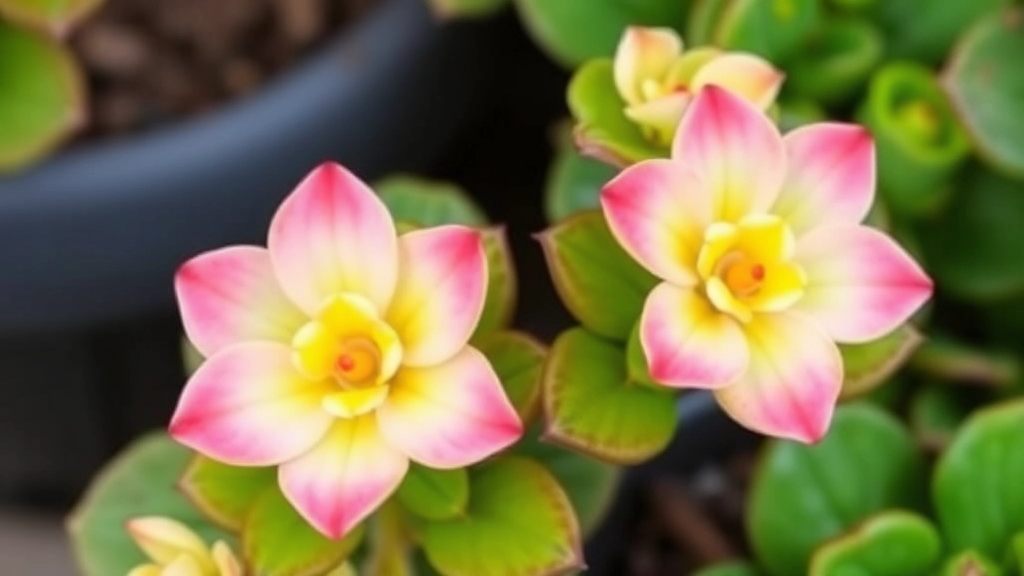
So, you’ve got your Kalanchoe, and you’re wondering how to keep it looking fabulous?
You’re not alone! Many plant lovers face the same challenge. Let’s dive into some straightforward care tips to ensure your Kalanchoe thrives.
Light Conditions
- Bright, Indirect Light: Kalanchoes love the sun but can get sunburned.
- Rotate Regularly: Give all sides some sunshine by rotating the pot every few weeks.
Watering
- Let It Dry: Allow the top inch of soil to dry out before watering again.
- Drainage is Key: Make sure your pot has drainage holes to prevent soggy roots.
Temperature
- Warm and Cozy: Kalanchoes prefer temperatures between 15°C to 25°C.
- Avoid Cold Drafts: Keep them away from chilly windows or air conditioning vents.
Fertilizing
- Feed Sparingly: Use a balanced, water-soluble fertiliser during the growing season, but only once a month.
- Skip Winter: No need to fertilise in the colder months.
Pruning
- Keep It Neat: Trim any dead or wilted leaves to encourage new growth.
- Encourage Blooms: Pinch off spent flowers to promote further blooming.
Pest Control
- Watch for Pests: Keep an eye out for mealybugs and aphids. A gentle wash with soapy water usually does the trick.
- Natural Remedies: Neem oil can be a great natural pest deterrent.
Ideal Soil and Light Conditions for Different Species
As we delve deeper into the world of Kalanchoe, understanding the ideal soil and light conditions for each species is crucial for their thriving growth.
Soil Requirements
Kalanchoe plants generally prefer well-draining soil to prevent root rot. Here are some essential tips for selecting the right soil:
- Cactus Mix: A pre-mixed cactus or succulent soil works wonders.
- Additives: Consider adding perlite or sand to improve drainage.
- pH Level: Aim for a slightly acidic to neutral pH (around 6.0 to 7.0).
Example: If you’re potting a Kalanchoe Blossfeldiana, a standard cactus mix will give it the drainage it craves. For more detailed care tips, check out the Flaming Katy Kalanchoe Blossfeldiana Care Guide.
Light Conditions
Light is another critical factor in Kalanchoe care. Different species have varying light needs:
- Bright, Indirect Light: Most Kalanchoe thrive in bright but indirect sunlight.
- Direct Sunlight: Some varieties, like the Mother of Thousands, can tolerate direct sunlight for a few hours each day.
- Low Light: Although not ideal, certain species can survive in lower light conditions, but growth may be stunted.
Tip: Rotate your plants every few weeks to ensure even light exposure. For specific guidance on caring for Mother of Thousands, visit our Complete Guide to Growing Kalanchoe Mother of Thousands.
Finding the right balance of soil and light can transform your Kalanchoe into a flourishing centerpiece.
Frequently Asked Questions About Different Kalanchoe Species
What makes Kalanchoe Blossfeldiana a popular choice?
Kalanchoe Blossfeldiana is favored for its vibrant, long-lasting blooms in various colors like red, pink, yellow, and white. It’s also easy to care for, making it ideal for beginners.
How should I care for my Kalanchoe Blossfeldiana?
Place it in bright, indirect sunlight, allow the soil to dry out between waterings, and keep it in a warm room between 15°C and 25°C.
What are some popular flowering Kalanchoe varieties?
Popular varieties include Kalanchoe Blossfeldiana, Kalanchoe Tomentosa (Panda Plant), and Kalanchoe Pinnata (Mother of Thousands). Each offers unique blooms and foliage.
How do I care for flowering Kalanchoes?
Provide bright, indirect sunlight, water when the top inch of soil is dry, maintain temperatures between 18°C to 24°C, and fertilize monthly during the growing season.
What makes Kalanchoe Beharensis stand out?
Kalanchoe Beharensis is notable for its large size, unique paddle-shaped leaves with a velvety texture, and sturdy stems. It can grow up to 1.2 meters tall.
What are the care tips for Kalanchoe Beharensis?
Ensure it gets bright, indirect sunlight, allow the soil to dry out between waterings, and use a well-draining cactus mix for the soil.
Why should I consider hanging Kalanchoe species?
Hanging Kalanchoe species are space-saving, visually appealing with their cascading leaves and flowers, and easy to care for, making them perfect for small spaces.
What are some popular hanging Kalanchoe varieties?
Popular hanging varieties include Kalanchoe Tomentosa (Panda Plant), Kalanchoe Marmorata (Chocolate Soldier), and Kalanchoe Beharensis (Felt Plant).
How do I care for hanging Kalanchoe species?
Provide bright, indirect sunlight, let the soil dry out between waterings, and use a diluted cactus fertilizer during the growing season.
What general care tips should I follow for Kalanchoe plants?
Ensure they get bright, indirect light, water when the top inch of soil is dry, maintain temperatures between 15°C to 25°C, and fertilize sparingly during the growing season.
How can I control pests on my Kalanchoe plants?
Watch for common pests like mealybugs and aphids. A gentle wash with soapy water or using neem oil can help deter pests naturally.
References
-
Kalanchoe Care: Growing Kalanchoe As A Houseplant
-
How to Grow Kalanchoe Succulents
-
Kalanchoe: How to Grow and Care for Kalanchoe Plants
